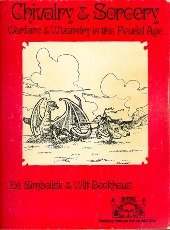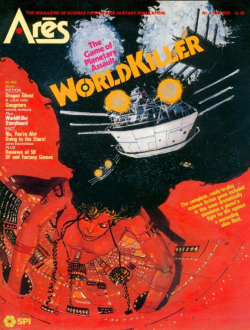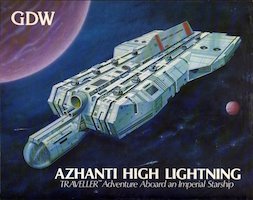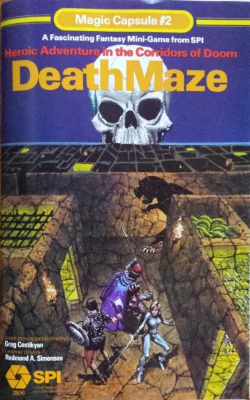Related Research Articles

Chivalry & Sorcery is a fantasy role-playing game (FRP) first published in 1977 by Fantasy Games Unlimited. Created by Edward E. Simbalist and Wilf K. Backhaus in 1977, Chivalry & Sorcery (C&S) was an early competitor to Dungeons & Dragons (D&D). The designers of the game were dissatisfied with the lack of realism in D&D and created a gaming system derived from it, named Chevalier. They intended to present it to Gary Gygax at Gen Con in 1977 but changed their minds once at Gen Con once they met Scott Bizar who wrote out a letter of intent. After some changes eliminated the last remnants of D&D, Simbalist and Backhaus published the first edition of their game, now renamed Chivalry & Sorcery.

Ares was an American science fiction wargame magazine published by Simulations Publications, Inc. (SPI), and then TSR, Inc., between 1980 and 1984. In addition to the articles, each issue contained a small science-fiction-themed board wargame.

Magic Realm is a fantasy adventure board game designed by Richard Hamblen and published by Avalon Hill in 1979. Magic Realm is more complex than many wargames and is somewhat similar to a role-playing game. It can be played solitaire or with up to 16 players and game time can last 4 hours or more. The game board is a type of geomorphic mapboard constructed of large double-sided hexagon tiles, ensuring a wide variety of playing surfaces.

Azhanti High Lightning is a science-fiction wargame, designed by Frank Chadwick and Marc W. Miller, illustrated by Paul R. Banner, Charmaine Geist, Richard Hentz, and Richard Flory, and published by Game Designers Workshop (GDW) in 1980. The title is the name of the large military starship that provides the setting for close-action combat between individuals on board. Azhanti High Lightning is the fourth Traveller boardgame published by GDW. It was republished in 2004 as part of Far Future Enterprises's (FFE) Traveller: The Classic Games, Games 1-6+. Originally Supplement 5: Lightning Class Cruisers was only available as part of this game, it was republished in 2000 as part of FFE's Traveller Supplements volume.

Deathmaze is a fantasy board game published by Simulations Publications (SPI) in January 1980 that falls into the general category of dungeon crawls, more specifically, dungeon games in which players enter a dungeon, massacre the dungeon dwellers and steal their treasures.

High Fantasy is a fantasy role-playing game system originally published by Fantasy Productions in 1978. A second edition in 1981 and several subsequent books were published by Reston Publishing that featured solo adventures using the High Fantasy system. The game received mixed reviews in game periodicals including White Dwarf, The Space Gamer, Different Worlds, Ares, and Dragon.

Thieves' World is a role-playing game supplement published by Chaosium in 1981, based on the Thieves' World series of novels. It was notable for including rules and statistics allowing for its use with nine different fantasy and science-fiction RPG gaming systems.

Land of the Rising Sun is a fantasy role-playing game, designed by Lee Gold and published by Fantasy Games Unlimited (FGU) in 1980 that is set in feudal Japan.

Adventures in Fantasy is a role-playing game published by Excalibre Games in 1979, designed by Dave Arneson and Richard Snider. The game is a fantasy system, similar to early Dungeons & Dragons (D&D), which Arneson co-created. It received mixed to negative reviews in game periodicals, including The Space Gamer, Ares, and Pegasus, and ultimately flopped. Arneson later bought the rights to Adventures in Fantasy and published a new edition in 1981 through his own company Adventure Games.

Star Patrol is a science fiction role-playing game published by Gamescience in 1977.

Chitin: I is a science fiction microgame published by Metagaming Concepts in 1977 in which bands of intelligent insects vie for resources.

Lords of the Middle Sea is a 1978 board wargame published by Chaosium. Designed by Lynn Willis, with art by William Church and Gene Day.

Mythology, subtitled "A Game of Adventure in the Age of Heroes", is a fantasy board game published by Yaquinto Publications in 1980.

The Compleat Fantasist is a 1980 role-playing game supplement published by Dimension Six.
Shooting Stars is a 1980 board game published by Yaquinto Publications.

Martial Metals was a company that produced miniature figures in the 1970s and 1980s for science-fiction tabletop games.
Amoeba Wars is a 1981 board game published by Avalon Hill.
Dark Stars is a 1980 board game published by Simulations Canada.
Ultra-Warrior is a 1981 board game published by Task Force Games.

Adventures In High Fantasy is a 1981 role-playing game adventure published by Reston Publishing for High Fantasy.
References
- 1 2 3 Barton, William A. (April 1981). "Capsule Reviews". The Space Gamer . Steve Jackson Games (38): 31.
- ↑ Goldberg, Eric (September 1981). "Games". Ares Magazine . Simulations Publications, Inc. (10): 30-31.
- ↑ O'Neill, John (2013-09-04). "Vintage Treasures". Black Gate. Retrieved 2022-03-10.